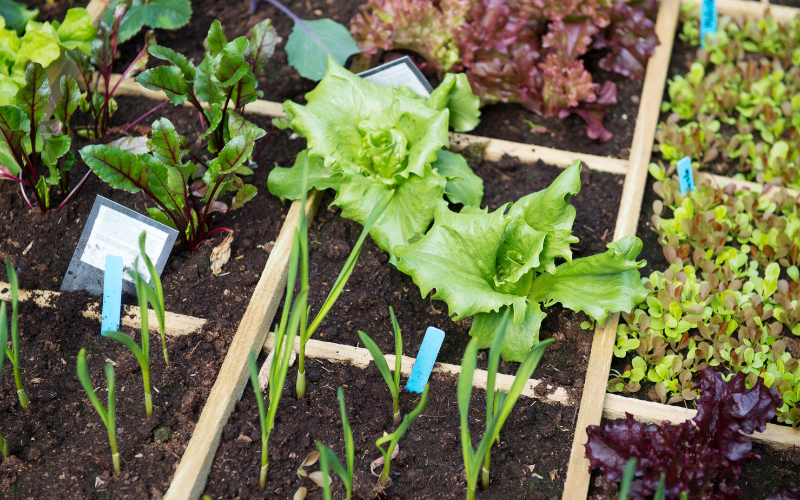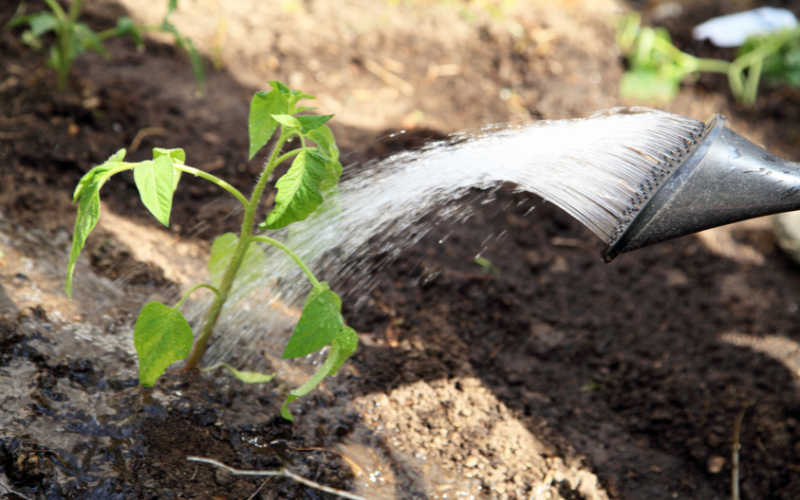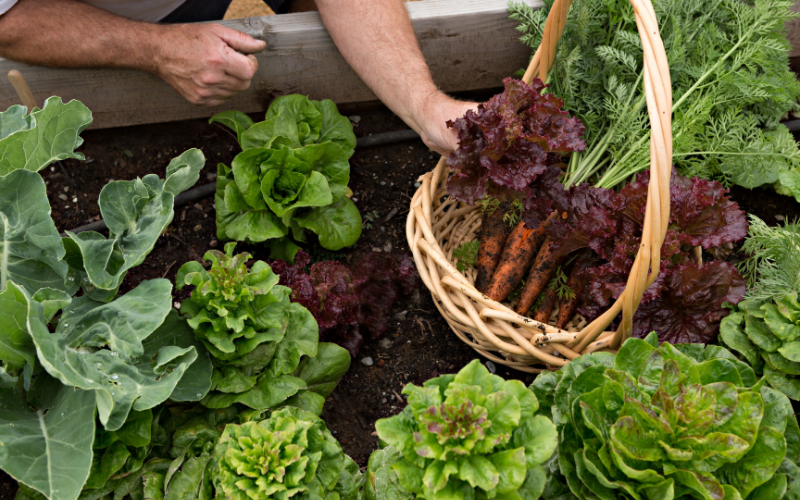Are you looking to start your own vegetable garden? Whether you have a large backyard or a small balcony, vegetable gardening can be a fun and rewarding hobby. Growing your own fresh produce not only saves you money, but also provides you with healthy and delicious food. In this article about vegetable gardening for beginners, we’ll guide you through the basics of vegetable gardening so you can get started today.
12 Essential Steps for Starting a Successful Vegetable Garden

Step 1: Choose the Right Location
When it comes to vegetable gardening, location is key. Make sure your garden gets at least six hours of direct sunlight each day. Vegetables need plenty of light to grow and produce food. If you’re growing vegetables in containers, you can place them in a sunny spot on your balcony or patio. If you have a backyard, choose a spot that gets direct sunlight for at least six hours a day. If your yard doesn’t have an area that gets enough sun, you can consider using raised beds or containers to bring the garden to a sunny spot.
Step 2: Prepare the Soil
Healthy soil is essential for growing healthy vegetables. Test your soil to determine the pH level and add the necessary amendments to achieve a pH of 6.0 to 7.0, which is ideal for most vegetables. You can purchase a soil test kit at a garden center or online. After testing your soil, add lime to raise the pH or sulfur to lower the pH as needed. You can also add compost or organic matter to improve the soil’s fertility. Compost provides essential nutrients and helps improve the structure of the soil.
Step 3: Choose the Right Plants
When choosing vegetables to grow, consider your climate and the growing season. For example, tomatoes and peppers require a longer growing season, so they’re better suited for warmer climates. Cool-season vegetables like lettuce and spinach can be grown in cooler climates. Research the best vegetables for your area and choose plants that will grow well in your climate. Make sure to select varieties that are suitable for your growing conditions and the time of year.
Step 4: Plan Your Garden
To make the most of your space, it’s important to plan your garden carefully. Consider using raised beds, which make it easier to control the soil and keep weeds at bay. Choose plants that will complement each other and avoid overcrowding, which can lead to disease and pest problems. When planning your garden, also consider the height and spread of each plant so you can arrange them in a way that makes the most of your space. Consider planting taller plants in the back and shorter plants in the front.
Step 5: Plant and Care for Your Vegetables

Plant your seeds or seedlings according to the instructions on the seed packet or the plant label. Make sure to water your vegetables regularly, especially during dry spells. Fertilize your plants with a balanced fertilizer and mulch the soil to conserve moisture and suppress weeds. Keep an eye out for pests and diseases and address any problems promptly. Regularly check the soil moisture and adjust your watering schedule as needed.
Step 6: Monitor for Pests and Diseases
As your vegetables grow, it’s important to keep an eye out for pests and diseases that can harm your plants. Common garden pests include aphids, slugs, and caterpillars. To control pests, you can use natural methods such as companion planting or handpicking, or you can use insecticides. If you notice any signs of disease, such as yellowing leaves or stunted growth, remove affected plants and destroy them to prevent the spread of the disease.
Step 7: Keep Your Garden Weeded
Weeds can compete with your vegetables for nutrients, water, and sunlight, so it’s important to keep them under control. Regularly removing weeds by hand or using a hoe is the best way to keep your garden weed-free. You can also mulch the soil around your plants to suppress weed growth.
Step 8: Rotate Your Crops
Rotating your crops is an important part of vegetable gardening that can help improve soil health and prevent disease. Basically, it involves planting different types of vegetables in different areas of your garden each year. This helps to reduce the buildup of pests and diseases in the soil, which can improve the health and productivity of your plants. When planning your garden, make sure to take crop rotation into consideration and plan your planting accordingly.
Step 9: Pest Control
When it comes to pest control in vegetable gardening, it’s important to use methods that are safe for both you and your plants. Some natural methods for controlling pests include planting companion plants, using row covers to protect your plants from insect damage, and attracting beneficial insects like ladybugs, which feed on pests like aphids. If necessary, you can also use approved pest control products, but always read and follow the label instructions carefully.
Step 10: Keep Records
Keeping records of your vegetable garden can be a valuable tool for learning and improvement. In addition to writing down what you planted, when you planted it, and how it performed, you can also keep track of the soil conditions, weather, and any other factors that may have affected your plants. This information can help you make more informed decisions for the next growing season, such as what plants to plant, when to plant them, and how to care for them.
Step 11: Harvest Your Vegetables

The moment you’ve been waiting for – it’s time to harvest your vegetables! Make sure to pick your vegetables at the right time, when they’re at their peak of ripeness. This will ensure the best flavor and texture. Some vegetables, like tomatoes, will continue to ripen after they are picked, while others, like lettuce, are best eaten when they are fully mature. Check the seed packet or the plant label for information on when to harvest each vegetable.
Step 12: Enjoy Your Garden
While growing a vegetable garden can be a lot of work, it’s also important to enjoy the process and the results. Taking time to appreciate the beauty of your garden and the fresh produce you’re growing can be a rewarding experience. Sharing your harvest with friends and family can also be a great way to connect with others and spread the joy of gardening. Additionally, gardening has been shown to reduce stress and improve overall well-being, so make sure to take time to relax and enjoy your garden.
Next Steps for Your Vegetable Garden
Once you have mastered the basics of vegetable gardening for beginners, it is a good idea to look into the next steps.
Extending the Growing Season:
In most climates, the growing season is limited. However, you can extend the growing season by using techniques such as starting seeds indoors, using season extension methods like cold frames or row covers, and growing heat-loving vegetables in the summer.
Composting:
Composting is an excellent way to recycle organic matter and improve soil fertility. It’s simple to start a compost bin in your own backyard. All you need is a container, some brown materials (like leaves or straw), green materials (like kitchen scraps and grass clippings), and water. Turn the compost regularly to ensure proper aeration and decomposition. When the compost is ready, you can use it to amend your garden soil and provide nutrients to your plants.
Irrigation:
Water is essential for the growth of your plants, but it’s also important to make sure you don’t overwater. Determining how often to water your garden can be a challenge, but a general rule of thumb is to water deeply once or twice a week, depending on the weather and soil type. Installing a drip irrigation system or using a watering can with a fine spray nozzle can help conserve water and reduce waste.
Succession Planting:
Succession planting is a technique where you plant a new crop in the same space as soon as one crop has finished producing. This allows you to maximize the use of your garden space and continue to harvest fresh produce throughout the growing season. For example, you can plant lettuce in the spring, followed by tomatoes in the summer, and fall greens in the fall.
Benefits of Vegetable Gardening
Aside from the obvious benefit of fresh produce, vegetable gardening has many other benefits. It allows you to control the use of pesticides and fertilizers, which can be harmful to your health and the environment. Gardening also provides a great form of exercise, and being in nature has been shown to improve mental health. Additionally, gardening can be a fun and educational activity for families to do together, teaching children about the importance of where their food comes from and how it grows.
Starting a Container Garden
If you don’t have a backyard, don’t worry! You can still grow your own vegetables in containers. Container gardening is a great option for apartment dwellers, those with limited outdoor space, or those with poor soil. Choose containers that are at least 12 inches deep and have drainage holes. Fill the containers with a high-quality potting mix and choose vegetables that are well-suited for container gardening, such as cherry tomatoes, strawberries, sweet potatoes, lettuce, and herbs.
Conclusion
In conclusion, vegetable gardening can be a fun and rewarding hobby for people of all ages and experience levels. With the right tools and techniques, you can grow a successful garden and enjoy the benefits of fresh, healthy produce. Whether you have a large backyard or a small balcony, there’s always room for a vegetable garden. Get started today and discover the joys of vegetable gardening!


1 thought on “Vegetable Gardening for Beginners: The Essential 12-Step Guide”